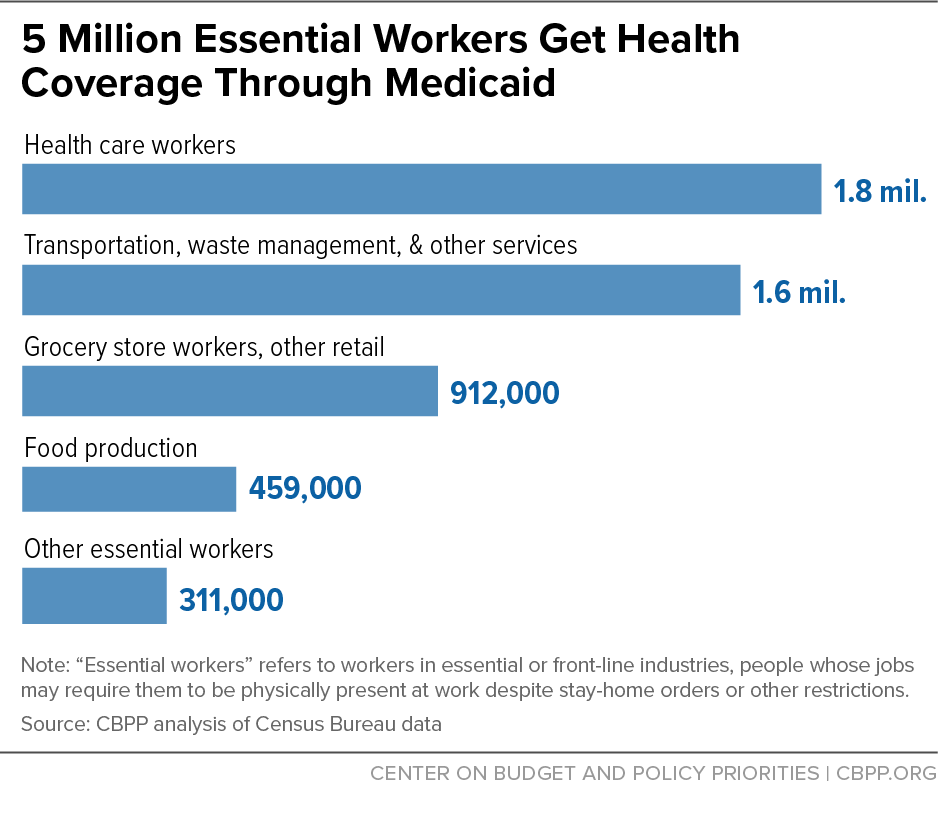más allá de los números
5 Million Essential and Front-line Workers Get Health Coverage Through Medicaid
With millions more Americans now jobless or experiencing sharp income losses due to the COVID-19 economic crisis, the need for Medicaid coverage is growing. Meanwhile, a major state budget crisis has already driven some states to cut Medicaid and other health programs. With states beginning to exhaust their options to avoid budget cuts, more states will likely make harmful Medicaid cuts unless federal policymakers provide additional Medicaid funds for them and maintain strong protections for Medicaid enrollees. Some 5 million Medicaid enrollees who work in essential or front-line industries would be among those who stand to lose if states cut Medicaid or if beneficiary protections are weakened, our analysis of Census data shows.
Medicaid is a crucial source of health coverage for workers in essential or front-line industries — people with jobs that may require them to show up for work during the pandemic regardless of stay-at-home orders or other restrictions, such as hospital workers, home health aides, food manufacturers, grocery store workers, farm workers, pharmaceutical manufacturers and pharmacy workers, bus drivers and truck drivers, and warehouse workers. Many low-income workers in these jobs are not offered job-based coverage or can’t afford the premiums for it.
Using Census Bureau data, we estimate the number of workers in these types of jobs enrolled in Medicaid in 2018, the most recent year for which data are available. As explained in more detail here, we categorize people as working in an essential or front-line industry if they work in specific industry categories. The definition is imperfect in that it undoubtedly includes some workers who were furloughed or are working remotely while excluding others who have been required to be physically present at work during the pandemic. But, we believe, it provides a reasonable window into health coverage for workers in jobs that potentially put them on the front lines of the pandemic.
About 5 million people in essential or front-line industries are enrolled in Medicaid, we estimate, including nearly 1.8 million people working in front-line health care services and 1.6 million in other front-line and essential services including transportation, waste management, and child care. (See figure.) Nationwide, 10 percent of all — and nearly 1 of every 3 low-income — essential or front-line workers are enrolled in Medicaid.
These workers are more than twice as likely to have Medicaid coverage — and 42 percent less likely to be uninsured — if they live in one of the 37 states and the District of Columbia that have expanded Medicaid to low-income adults. (See table.) Another 650,000 essential or front-line workers who are currently uninsured would be eligible for Medicaid coverage if the remaining states adopted the Affordable Care Act’s Medicaid expansion, we estimate.
The stakes are high for Medicaid as the President and Congress negotiate another economic relief bill. Unfortunately, the Senate Republican proposal doesn’t include additional increases in the federal share of Medicaid costs (the federal medical assistance percentage, or FMAP), which states need to avoid harmful cuts. And Republicans may seek to weaken important maintenance-of-effort protections, enacted in the Families First Coronavirus Response Act in March, that prevent states from cutting Medicaid eligibility or taking away people’s coverage during the public health crisis.
A final relief bill that weakens these protections or doesn’t provide additional Medicaid funding could hurt millions of essential and front-line workers who are sacrificing to help the nation through the pandemic.
| TABLE 1 | |||
|---|---|---|---|
| Millions of Essential or Front-Line Workers Are Enrolled in Medicaid | |||
| State | Essential/front-line workers enrolled in Medicaid | % of all essential/front-line workers enrolled in Medicaid | % of low-income essential/front-line workers enrolled in Medicaid |
| United States | 5,009,800 | 10% | 29% |
| Medicaid expansion states | 4,175,500 | 12% | 37% |
| Non-expansion states | 834,300 | 5% | 15% |
| Alabama | 28,100 | 4% | 13% |
| Alaska* | 14,200 | 11% | 33% |
| Arizona* | 110,900 | 11% | 32% |
| Arkansas* | 56,900 | 11% | 30% |
| California* | 950,100 | 16% | 42% |
| Colorado* | 93,000 | 11% | 34% |
| Connecticut* | 75,100 | 14% | 48% |
| Delaware* | 21,500 | 15% | 38% |
| District of Columbia* | 17,700 | 19% | 59% |
| Florida | 175,000 | 6% | 15% |
| Georgia | 66,700 | 4% | 12% |
| Hawai’i* | 13,500 | 7% | 25% |
| Idaho** | 12,100 | 5% | 11% |
| Illinois* | 204,400 | 10% | 34% |
| Indiana* | 69,400 | 7% | 23% |
| Iowa* | 57,800 | 10% | 34% |
| Kansas | 17,800 | 4% | 10% |
| Kentucky* | 84,100 | 13% | 36% |
| Louisiana* | 105,300 | 16% | 37% |
| Maine** | 19,700 | 8% | 26% |
| Maryland* | 106,800 | 12% | 39% |
| Massachusetts* | 179,000 | 16% | 54% |
| Michigan* | 180,400 | 13% | 38% |
| Minnesota* | 130,500 | 13% | 45% |
| Mississippi | 22,700 | 5% | 13% |
| Missouri | 47,700 | 5% | 16% |
| Montana* | 20,100 | 12% | 30% |
| Nebraska** | 17,700 | 5% | 16% |
| Nevada* | 35,200 | 10% | 26% |
| New Hampshire* | 17,400 | 8% | 38% |
| New Jersey* | 133,200 | 9% | 32% |
| New Mexico* | 57,600 | 22% | 47% |
| New York* | 553,700 | 18% | 49% |
| North Carolina | 85,600 | 6% | 16% |
| North Dakota* | 7,300 | 5% | 21% |
| Ohio* | 218,400 | 12% | 38% |
| Oklahoma** | 27,700 | 5% | 13% |
| Oregon* | 74,600 | 12% | 33% |
| Pennsylvania* | 228,600 | 10% | 36% |
| Rhode Island* | 23,200 | 14% | 48% |
| South Carolina | 46,300 | 6% | 18% |
| South Dakota | 9,000 | 5% | 14% |
| Tennessee | 82,300 | 8% | 23% |
| Texas | 166,700 | 4% | 10% |
| Utah** | 19,200 | 4% | 12% |
| Vermont* | 15,500 | 14% | 40% |
| Virginia** | 50,000 | 4% | 16% |
| Washington* | 134,400 | 12% | 37% |
| West Virginia* | 39,300 | 15% | 41% |
| Wisconsin | 82,600 | 8% | 27% |
| Wyoming | 3,500 | 4% | n/a |
n/a We do not report estimates that are based on an unweighted sample of fewer than 40 people.
* These states adopted the Medicaid coverage expansion to low-income adults no later than 2018.
** These states adopted the Medicaid coverage expansion after 2018 and so the data are not reflective of current Medicaid participation among essential or front-line workers.
Source: CBPP analysis using the Census Bureau’s 2018 American Community Survey. Estimates are rounded to the nearest hundred and the nearest percent. “Low-income” is defined as family income at or below 200 percent of the federal poverty line. “Essential/front-line workers” are defined as those currently working in any of the following industry categories: essential food production, essential manufacturing (including medicine), essential public services (including civic and public safety), essential transportation, essential utilities, essential warehousing, front-line health care services, front-line retail, and front-line services (including transportation and child care).

